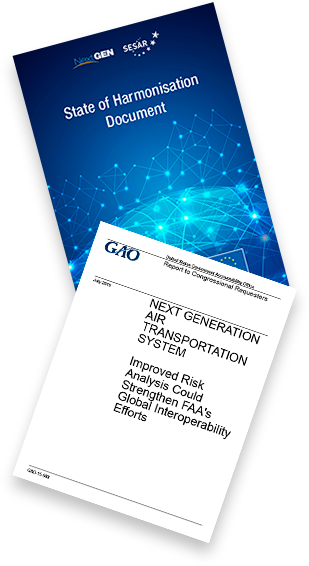
Safe interoperability of new aeronautical communications, navigation and air traffic surveillance systems — being implemented now in the European Union (EU) and the United States and, with varying extents and timing, elsewhere — has received heightened government-industry attention in the past nine months.
Several reports and conference presentations address concerns expressed about new aspects of air traffic management (ATM) by aircraft manufacturers, air navigation service providers (ANSPs), pilots, airlines, regulators and other stakeholders. Some relatively imminent changes will not be as seamless as anticipated, they say, leaving questions about how they will mitigate operational risks.
Harmonization, seen as a component of interoperability, was a recurrent theme in a number of panel presentations and questions during the RTCA 2015 Global Aviation Symposium on June 3–4 in Washington, in a joint December 2014 report by the EU and the United States,1 and in a July report2 by the U.S. Government Accountability Office (GAO) concerning the Federal Aviation Administration’s (FAA’s) capability to assess and manage risks in this domain (see “Encouraging NextGen Interoperability”).
“Global interoperability makes air-traffic management systems and procedures compatible all over the world, allowing the seamless transition of aircraft and aviation information across national borders,” the GAO report said. Distinguishing between the terms interoperability and harmonization in this context, the GAO report explained its use of the first term as meaning “the capability of two or more air-traffic management systems and procedures to accept and use information and services from each other for technical or operational purposes, enabling them to operate effectively together” and the second as meaning “the agreement on and implementation of compatible standards, procedures and technologies (and associated policy) to ensure interoperability.
 “As modernization efforts proceed worldwide, collaboration — both within FAA and with domestic and international aviation stakeholders — will be critical to developing modernized ATM systems and procedures that allow aircraft to seamlessly transition from one system to another, help enhance safety, and ensure the greatest operational and performance benefits to aviation users.”
“As modernization efforts proceed worldwide, collaboration — both within FAA and with domestic and international aviation stakeholders — will be critical to developing modernized ATM systems and procedures that allow aircraft to seamlessly transition from one system to another, help enhance safety, and ensure the greatest operational and performance benefits to aviation users.”
The U.S.–EU joint report notes a few downsides when collaboration proves unsuccessful. “Essentially [harmonization for interoperability] means that flights will be able to operate in both U.S. and European ATM environments with the same set of capabilities in the on-board equipment to navigate, communicate and report their position. Failure to meet this global demand for harmonisation and interoperability runs the risk of burdening airspace users with the need to carry different types of capabilities, and causing them to bear the associated additional costs. … It is widely understood that the systems cannot be completely identical. But harmonisation is necessary to ensure that the same flight/aircraft can operate in all systems; ensure that common standards are available when needed; and minimise costs by sharing results and efforts.”
Most of the recent discussion has centered around the Next Generation Air Transportation System (NextGen) in the United States and the Single European Sky ATM Research Programme (SESAR) in Europe. They currently are the world’s largest airspace modernization projects under way, and NextGen is the largest and most complex, several specialists noted. Key objectives are “to improve overall aviation system performance, particularly in the areas of flight efficiency and environmental impact, while also meeting expected demands for increased capacity and continuing to maintain the highest levels of safety.”
Joint Report Background
The joint report provides background for understanding RTCA panelists’ discussions of the issue and the GAO assessment of collaborative efforts. “Both NextGen and SESAR recognise the need to integrate the air and ground parts of their air traffic management systems by addressing efficiency needs of flight trajectories planning and execution and the seamless sharing of accurate information. The U.S./EU joint harmonisation work will assure that modernisation and advances in air navigation systems worldwide can be made in a way that supports cooperation, clear communication, seamless operations and optimally safe practices,” the report said.
Examples of the status of collaborative efforts appear in the report, including explanations of areas in which agreements had not been reached as of December 2014. As an example of one of the most successful areas of trans-Atlantic collaboration so far, the report cited the advances in air-to-ground and air-to-air data communications services (datacomm). “The [parties’ Memorandium of Cooperation] proved an effective framework for resolving differences related to the scope of the datacomm services standards. As a result, there is an agreed-upon time line path towards full convergence on the [Aeronautical Telecommunication Baseline 2 (ATN B2)] datacomm services standard,” the report said.
Another success story cited in the same report was the leadership agreement that produced the baseline NextGen/SESAR Joint Avionics Roadmap, which “identifies and provides timelines for the developing aircraft capabilities for navigation, surveillance and data communications in the evolution of an airborne/ground integrated ATM concept and architecture,” and associated regulatory guidance material scheduled for publication in 2016.
In contrast, a problematic component of modernization has been the three-phase recategorization3 of aircraft wake turbulence separation standards known as RECAT (ASW, 9/15). “U.S. and Europe did not reach an agreement on a common set of separation minima to form the global proposal to ICAO [International Civil Aviation Organization] for RECAT II,” the report said. “A working arrangement between the respective safety regulators (EASA [the European Aviation Safety Agency] and FAA Flight Standards) on determining wake turbulence separation minima for new heavy aircraft is being prepared. This would provide a stronger basis to re-start the work on the common RECAT II proposal to ICAO.”
Regarding four-dimensional aircraft trajectory management to improve air traffic operations and increase the overall predictability of the air traffic system — known as 4DT, the post-modernization capability to use a larger set of data (including longitude, latitude, altitude and time), the report said, “The U.S. and Europe are reaching agreement on exchange of ground-to-ground and air-to-ground trajectories, including the formats. However, work remains to be done on integrating the concept of dynamic interaction between ground ANSP systems and the airborne flight deck and avionics systems. … Affirmed commitment was made to the standards development in RTCA and EUROCAE industry standardisation bodies of the first standard to allow for the European implementation of initial four-dimensional trajectory[–]based operations (i4D) and subsequently to allow for the U.S. implementation with a second release of the standard for the full convergence on a common ATN B2 service standard [by 2025].”
Regarding automatic dependent surveillance services and technology, the joint report cites success in ground surveillance applications based on automatic dependent surveillance–broadcast (ADS-B) and airborne separation assistance systems (ASAS) for air traffic control (ATC). The applications are being designed to increase pilots’ situational awareness on the flight deck in common ways, to support airborne-spacing applications, and later to include development of automated airborne-separation applications.

U.S. Auditor’s Perspective
The mid-2015 GAO report, based on interviews with 25 international specialists including FAA officials, said, “According to FAA officials, potential risks to NextGen’s interoperability are identified and assessed through working groups.” The report cited as examples of NextGen components involving significant risk-mitigation challenges performance-based navigation (PBN), datacomm, ADS-B and systemwide information management (SWIM).
The report said that in addition to working collaboratively via bilateral agreements with state/regional aviation regulatory bodies, FAA NextGen specialists interface with their SESAR counterparts regarding harmonization and interoperability issues mainly through 13 RTCA and EUROCAE joint special committees. One issue involves European and U.S. technologies that differ for various reasons. The report noted that a number of stakeholders interviewed by GAO typically mentioned ADS-B, datacomm and SWIM as modernization components with important interoperability issues still being resolved.
At the global level, communicating information across national borders has been planned by ICAO to occur in discrete building blocks of capabilities over a longer time than NextGen and SESAR, and based on local and regional infrastructure/risk-mitigation needs. “A single approach may not be applicable to all countries or regions because there is wide variation among countries with regard to levels of traffic density, traffic complexity, and ATM infrastructure,” the report said. “Therefore, ATM systems do not need to be identical in order to be interoperable — i.e., systems and aircraft can accept and use information and services from each other for technical or operational purposes, enabling them to operate effectively together.”
One issue that the European Commission has faced is that European states sometimes have not agreed with the regional consensus about which technologies to adopt, the report said. Stakeholders said this was the case with resistance by some ANSPs to implementing ADS-B ground infrastructure, opening a possibility of some choosing incompatible technical solutions. Similar objections to local implementations of SWIM technology “may restrict the capability for information sharing,” the report added as an example.
The United States also has reached some decisions that are expected to impede interoperability of datacomm for a period of time, according to the GAO report and RTCA symposium panelists. The report said that “the FAA and EU agreed on a plan to deploy the [ATN B2] capability for datacomm by 2025. The EU is beginning to roll out ATN Baseline 1 first, with a mandate for airlines to equip by 2020, followed by plans to implement ATN Baseline 2. On the other hand, FAA is using the Future Air Navigation System 1/A (FANS 1/A) for its first phase of datacomm capability enhancements and plans to deploy ATN Baseline 2 by 2021–22. According to FAA officials, FAA decided to not implement ATN Baseline 1 because aircraft operating in both North America and Europe are already equipped with FANS 1/A avionics for oceanic operations and FANS 1/A offers re-route capabilities that the EU’s ATN Baseline 1 does not. … The two approaches could require work-arounds for some aircraft operating in both environments, such as double-equipping aircraft or applying for exemptions, which may reduce benefits from datacomm capabilities.”
According to the report (and also noted by RTCA symposium panelists), EU officials have said that in the interim period, “aircraft that are only equipped with FANS 1/A will still be able to operate in European airspace but with more limited capabilities. However, EU officials noted that it will be important that by 2025 airlines operating in both the United States and Europe are equipped with ATN Baseline 2 to achieve benefits, and FAA and the EU will have to work together to develop standards for these future improvements.”
One of the potential sources of flight operations safety risks during implementation of airspace modernization, the GAO report said, citing comments from stakeholders, is the difficulty of decisions about when and how to equip aircraft with required technologies and “the necessity of developing specialized products and services for different ANSPs and the aircraft that operate within their airspace.
“For example, for ADS-B, at the time FAA issued the final rule mandating a performance standard for equipping aircraft, the standard could only be met using a Wide Area Augmentation System (WAAS) Global Positioning System (GPS) receiver. …. However, the WAAS GPS receiver is not required to meet ADS-B performance standards in Europe or Australia. Two airline stakeholders expressed concern that this difference may lead to different or additional equipage for aircraft flying to the [United States] than to other countries, but according to FAA officials, recent data has shown that under the current GPS satellite configuration, the FAA performance standard set in 2010 can be met without the WAAS GPS receiver.”
RTCA Panelists’ Comments
During the RTCA symposium, Joe DePete, first vice president, Air Line Pilots Association, International, commented that until harmonization creates seamless EU-U.S. datalink integration, “What I see myself in the aircraft is increased workload … as I transit airspace from one to another, as I go from one airport to another and [encounter] differences. … What I see is that the distractions in the cockpit go up.”
Chuck Stewart, chief technical pilot of United Airlines, said, “The question [about datacomm] is always good global harmonization … because right now we’re flying into Europe with a dual stack [of avionics]. We’ve got FANS 1/A and ATN on board the aircraft. We don’t want to do that. … What I mean by [having] synchronization is we’ve got to start integrating comm and surveillance and air traffic management. We still have stovepipes [of technology and expertise].
“Right now, we’ve got Europe with multi-program management [working] out a system with ATN, which is what they use for datalink. At the same time, in the United States, we have [FANS 1/A] and those are not compatible systems. So [we’ve] got to get back together somehow because, as we go forward, the [aviation] community is going to demand it.”
Rob Mead, chief program engineer, air/ground data communications, Boeing Research and Technology Airspace and Flight Efficiency, and Jerome Condis, multi-program datalink and flight management system manager, Airbus, jointly presented a chart essentially concurring on every detailed step of intended transition to interoperable avionics for the United States and Europe. “The globe is well covered right now by datacomm, and the standard produced by RTCA and some other committees has supported that happening,” Mead said. Testing capability of loading data from ground stations to aircraft was being done successfully as of mid-2015 with plans for a further 18 months of testing at 56 U.S. airports. “So that’s under way and rolling, and is a good, solid program,” he said, adding that the next phase will be data-loading capabilities for initial en route operations followed by full en route operations.
In the future, however, Boeing will build aircraft with “one and only one version … that is, the ability to use both the ATN B2 and the FANS capability seamlessly on an aircraft. … We will not plan to build a version for Europe and a version for the United States. …One of the things that’s been a pretty clear message over the years is that you need to keep on a path once you’ve started. There’s a lot of temptation to deviate and that path,” he said.
Condis added, “Europe decided more than one decade ago to go forward with [ATN controller-pilot datalink communication solely to replace voice communication, not for future trajectory-based flight operations] in the domestic airspace. Most of you know, I think, we have faced some issues with the deployment of the ATN since we turned it on … in the European airspace.” A SESAR project launched with participation of the full ATM community, however, has made Airbus “quite confident we’ll end up with a solution that will restore the ATN” and enhance capability through convergence of standards enabling global 4DT sharing, with a large-scale demonstration beginning in 2018. What he called the Airbus incremental approach will “support this early stage for validation and demonstration in Europe, but in the end, we have the same target, which is one and only one product in the aircraft that will be able to fly everywhere.”
Don Walker, surveillance team lead at FAA Avionics Systems Branch, said, “In order to really make trajectory-based operations work, we have to have a level of integration on the flight deck that simply doesn’t exist today. We need to have the surveillance system and the navigation system exchanging data, the datacomm system passing data over to the surveillance system and vice versa. We need to have new displays that provide the guidance to the pilots for the trajectory-based operations so that they can actually get the speed-guidance cues that they need. … We’ve got silos of disciplines both within the FAA and within industry that can address these things individually, but crossing the bridges between the silos has been historically very difficult. … When you have a problem that is on a boundary between major disciplines — sometimes even in funding the research you need to get the answer — it’s tough because ‘Who owns it?’”
Notes
- U.S.-EU MOC [Memorandum of Cooperation] Annex 1 – Coordination Committee, FAA and Office of the EU. “NextGen and SESAR State of Harmonisation Document,” December 2014. Australia, Canada, China and Japan are other examples of countries currently modernizing their ATM systems in collaboration with NextGen and SESAR counterparts.
- GAO. “Next Generation Air Transportation System: Improved Risk Analysis Could Strengthen FAA’s Global Interoperability Efforts.” Report no. GAO-15-608, July 2015.
- The joint report said RECAT I optimized existing ICAO wake turbulence separation classes with up to six categories; RECAT 2 will replace the separation classes with a “static ‘pair-wise’ regime, whereby each aircraft pair has its appropriate wake turbulence separation minima;” and RECAT 3, also called dynamic pair-wise separation, considers “actual conditions, such as aircraft mass and atmospheric/meteorological conditions … when establishing the required wake turbulence separation minima.”
Featured image: composite illustration, Susan Reed based on © TSUNG-LIN WU | AdobeStock
European air traffic: © National Air Traffic Services (NATS)

